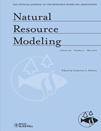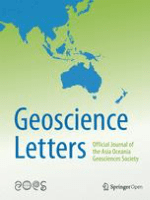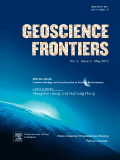
NATURAL RESOURCE MODELING
Scope & Guideline
Empowering scholars with critical methodologies for resource management.
Introduction
Aims and Scopes
- Mathematical and Computational Modeling:
The journal emphasizes the use of mathematical and computational models to analyze and predict the behavior of natural resources and ecosystems. This includes various modeling techniques such as stochastic models, agent-based models, and simulation approaches. - Sustainable Resource Management:
A core aim of the journal is to explore sustainable practices in managing natural resources, including fisheries, forestry, and water resources. It often discusses policies and strategies that enhance conservation while balancing economic needs. - Interdisciplinary Research:
The journal promotes interdisciplinary research that integrates insights from ecology, economics, and social sciences to address complex issues related to natural resource management. - Impact of Climate Change:
There is a consistent focus on understanding the impacts of climate change on various ecosystems and resources, including studies on adaptation strategies and mitigation policies. - Socio-Ecological Systems:
Research often investigates the dynamics within socio-ecological systems, exploring how human activities and environmental changes interact and influence resource sustainability.
Trending and Emerging
- Climate Change Adaptation Strategies:
There is an increasing focus on developing models that assess and predict the impacts of climate change, as well as strategies for adaptation and resilience in various ecosystems. - Technological Integration in Resource Management:
Emerging trends include the application of advanced technologies such as machine learning, remote sensing, and GIS in modeling and managing natural resources effectively. - Ecosystem Services Valuation:
Research on valuating ecosystem services is gaining traction, highlighting the importance of integrating ecological benefits into economic decision-making and policy development. - Multi-Criteria Decision Analysis (MCDA):
The use of MCDA approaches in resource management is trending, allowing for more comprehensive evaluations that incorporate diverse stakeholder perspectives and objectives. - Biodiversity and Conservation Models:
There is a rising interest in modeling approaches that address biodiversity conservation, including the implications of human activities on species interactions and habitat connectivity.
Declining or Waning
- Traditional Resource Extraction Models:
There has been a noticeable decrease in publications focusing solely on traditional resource extraction models without considering the broader ecological impacts and sustainability concerns. - Single-Species Management Focus:
Research that primarily emphasizes single-species management strategies is becoming less common as the journal shifts towards more holistic approaches that consider multi-species interactions and ecosystem dynamics. - Static Environmental Assessments:
Papers that rely on static assessments of environmental conditions without incorporating dynamic modeling or adaptive management practices are declining, indicating a move towards more dynamic and responsive modeling frameworks.
Similar Journals

EARTH is a prestigious journal published by MDPI, located in Switzerland, with a commitment to advancing the fields of Earth and Planetary Sciences and Environmental Science. Launched in 2020, the journal emphasizes an open-access publication model, ensuring that high-quality research is widely accessible to the scientific community and beyond. As of 2023, it proudly holds a Q2 ranking in both the Environmental Science and Earth and Planetary Sciences categories, indicating its significant impact within these disciplines; it ranks #90 out of 219 and #70 out of 159 in their respective fields according to Scopus. With the convergence of multidisciplinary research and the critical challenges our planet faces, EARTH seeks to publish innovative studies that foster a deeper understanding of geological and environmental processes. Researchers, professionals, and students alike will find this journal an invaluable resource for the latest findings and discussions shaping our understanding of Earth sciences.

Geoscience Letters
Unlocking the Secrets of Our PlanetGeoscience Letters, published by Springer, is a prominent open-access journal in the field of Earth and Planetary Sciences, recognized for its dedication to advancing knowledge and research in this vital area of study. With a reported impact factor that reflects its esteemed position—ranking in the Q1 quartile of Earth and Planetary Sciences, particularly as the journal ranks #48 out of 195 in the general category according to Scopus—the journal serves as a vital resource for researchers, professionals, and students. Since its inception in 2014, Geoscience Letters has facilitated the dissemination of high-quality research and critical insights, aiming to bridge the gap between scientific discovery and societal needs. Its commitment to open access ensures that the latest findings are readily available to a global audience, thus enhancing collaboration and innovation within the geosciences community.

Geosystem Engineering
Connecting scholars to tackle pressing environmental issues.Geosystem Engineering, published by Taylor & Francis Ltd, is a prominent academic journal focusing on the interdisciplinary fields of Environmental Engineering, Pollution, and Waste Management and Disposal. With an ISSN of 1226-9328 and an E-ISSN of 2166-3394, this journal has been a significant contributor to the scholarly discussions since its inception in 1998 and continues to publish impactful research up to 2024. As a recognized journal within the Q3 category for its respective fields as of 2023, it serves as a vital platform for researchers, professionals, and students aiming to disseminate findings, share innovations, and address pressing environmental challenges. Although it does not currently offer Open Access options, Geosystem Engineering remains essential for those invested in advancing sustainable practices and technologies in geosystems. The journal delivers critical insights that contribute to the development of policies and practices aimed at improving environmental quality and waste management strategies globally.

Journal of Climate Change
Transforming research into actionable solutions for our Earth.The Journal of Climate Change, published by IOS PRESS, is a premier academic platform dedicated to the multidisciplinary investigation of climate change, its impacts, and mitigation strategies. With a focus on promoting innovative research, this journal aims to cultivate dialogue among researchers, policymakers, and environmental professionals globally. While the impact factor signifies its academic significance, the journal prides itself on providing unrestricted access to cutting-edge research insights, fostering collaboration within the scientific community. The journal’s ISSN is 2395-7611, and the E-ISSN is 2395-7697. Whether you are a seasoned researcher or a student exploring the critical implications of climate change, the Journal of Climate Change serves as an essential resource for the latest findings and discussions in this vital field.

Geoscience Frontiers
Empowering Geoscientific Innovation and CollaborationGeoscience Frontiers is a premier open-access journal that has been at the forefront of disseminating impactful research in the field of Earth and Planetary Sciences since its inception in 2010. Published by China University of Geosciences, Beijing, this journal operates from the Netherlands and has gained recognition for its rigorous peer-review process and high standards of scholarship, earning a distinguished position as Q1 in the Earth and Planetary Sciences category. With a Scopus ranking of 5 out of 195, placing it in the 97th percentile, it reflects the journal's commitment to addressing global geological challenges and advancing our understanding of the Earth’s dynamic systems. As an open-access platform, Geoscience Frontiers ensures that vital research is widely accessible, fostering collaboration and innovation among researchers, professionals, and students alike. By providing a forum for cutting-edge discoveries and theories, the journal plays a critical role in shaping the future of geoscientific research and education.

Chemical Product and Process Modeling
Catalyzing collaboration for the future of chemical engineering.Chemical Product and Process Modeling is a vital academic journal published by WALTER DE GRUYTER GMBH, focusing on the intricate intersection of chemical engineering and mathematical modeling. Since its inception in 2006, this journal has been instrumental in disseminating significant research findings and methodologies that advance the modeling and simulation of chemical products and processes. With an ISSN of 1934-2659, it caters to a global audience from its base in Berlin, Germany. Although positioned within the Q3 and Q4 quartiles in Chemical Engineering and Modeling & Simulation categories respectively in 2023, it offers a platform for innovative approaches and contributions in these fields, making it a resource for researchers and industry experts alike. Access to the journal's content is offered through subscription models, enabling professionals and academics to stay abreast of the latest developments. In a rapidly evolving scientific landscape, Chemical Product and Process Modeling remains dedicated to enhancing knowledge and fostering collaboration within the chemical engineering community.

ENVIRONMENTAL MANAGEMENT
Connecting research and policy for a greener future.ENVIRONMENTAL MANAGEMENT, published by Springer, stands at the forefront of advancing sustainability and ecological stewardship in the fields of Ecology, Global and Planetary Change, and Pollution. With an impressive tracking history from 1977 to 2024 and prestigious quartile rankings reflecting its significant impact (Q1 in Ecology and Q2 in both Global and Planetary Change and Pollution), this journal engages a wide range of stakeholders, including researchers, policymakers, and environmental professionals. The journal is a vital resource for those dedicated to addressing pressing global environmental challenges, publishing rigorous interdisciplinary research that informs policy and practice. While it does not offer open access, its content remains accessible through institutional subscriptions. Located in the heart of New York, ENVIRONMENTAL MANAGEMENT is dedicated to fostering a substantive dialogue on innovative approaches to environmental preservation and management.

JOURNAL OF THE AMERICAN WATER RESOURCES ASSOCIATION
Connecting researchers and practitioners in the vital realm of water resources.The JOURNAL OF THE AMERICAN WATER RESOURCES ASSOCIATION, published by Wiley, is a premier platform dedicated to advancing the field of water resource management and research. With an ISSN of 1093-474X and an impressive Q1 ranking in multiple categories, including Earth-Surface Processes, Ecology, and Water Science and Technology, this journal serves as a vital resource for professionals, researchers, and students alike. Established in 1967 and set to converge through 2024, it has consistently published cutting-edge research that influences policy and practice in water resource management. The journal's open access option enhances its reach, ensuring that critical findings are accessible to a wider audience. The Scopus rankings further underscore its impact, placing it in the top quartile within its fields, highlighting its importance in shaping scholarly discourse. As a significant contributor to the understanding and management of freshwater systems, the journal offers a crucial means for sharing insights and fostering collaboration in the vital realm of water resources.

CURRENT SCIENCE
Illuminating Pathways in Diverse Scientific DisciplinesCURRENT SCIENCE, published by the Indian Academy of Sciences, is a distinguished multidisciplinary journal that has been a cornerstone of scientific literature since its inception in 1945. With an ISSN of 0011-3891, it provides a platform for high-quality research articles that span a wide array of scientific disciplines, reflecting the dynamic landscape of contemporary science. The journal is currently ranked in the Q2 category, demonstrating its significant impact and contribution to the field, as evidenced by its position at Rank #69 out of 171 in the Scopus ranking system, placing it within the 59th percentile among its peers. CURRENT SCIENCE is not only a vital resource for researchers and professionals seeking to stay abreast of advancements but also serves as an educational tool for students across various scientific domains. Although it does not offer open access options, its robust editorial standards and commitment to disseminating noteworthy research make it an essential read for anyone invested in the pursuit of knowledge and innovation. Based in Bangalore, India, the journal continues to engage a global audience, ensuring that cutting-edge scientific discoveries and interdisciplinary dialogues are accessible to the wider scientific community.

Journal of Sustainable Mining
Innovating practices for a greener mining future.Journal of Sustainable Mining, published by the Glowny Instytut Gornictwa in Poland, is a premier open-access journal dedicated to advancing research in the field of sustainable mining practices. Since its inception in 2013, this journal has been a vital resource for specialists in Environmental Engineering, Geology, and Geotechnical Engineering, with an increasing focus on sustainability within these disciplines. With its current rankings placing it in the Q3 category across multiple related fields, the journal aims to foster innovation by disseminating high-quality, peer-reviewed research essential for the development of environmentally friendly mining solutions. Notably, it is indexed in Scopus, catering to a global audience of researchers, professionals, and students interested in sustainable practices that minimize environmental impact. As it continues to converge until 2024, the Journal of Sustainable Mining plays an integral role in shaping the discourse around responsible resource extraction, making it a must-read for anyone invested in the future of mining and environmental stewardship.